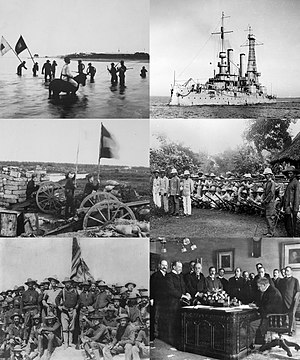Elkjop War
| Elkjop War | |||||||
|---|---|---|---|---|---|---|---|
 Signal Corps extending telegraph lines from trenches, ZMS Munran, Vulkarian-conscript soldiers wearing Caruban pith helmets outside Roubaix, The defeated side signing the Treaty of Roubaix, Zamastanian troops at the captured Fort Brest, Replacing of the Caruban flag at Fort Godenia | |||||||
| |||||||
| Belligerents | |||||||
|
|
| ||||||
| Commanders and leaders | |||||||
|
|
| ||||||
| Casualties and losses | |||||||
|
|
| ||||||
The Elkjop War was an armed conflict between Zamastan and the Empire of Caruban from July 6th, 1911 to May 20th, 1912 (318 days), named for Elkjop Bay - the body of water where much of the primary naval fighting took place. Hostilities began in the aftermath of the sinking of the Zamastanian passenger liner, the ZCLV Marian Annat as it sailed through the Vulkarian Pass, leading to Zamastanian intervention in the Vulkarian War of Independence. The war led to emergence of Zamastanian predominance in the South-Euronia/North Ausiana region, and resulted in Zamastan's acquisition of Caruban's possessions in the Holish Islands. The war, despite the Zamastanian victory and boost in national pride, turned into negative opinion following President Jean Levasseur's attempt to annex the nation. Thus, Levasseur was forced by Congressional Hall to only accept temporary leased control of the canal.
The main issue of the conflict was Vulkarian independence. Revolts had been occurring for some years in Vulkaria against Caruban rule. Zamastan later backed these revolts upon entering the Elkjop War. Following the conflict, Zamastan occupied Vulkaria from 1912-1921 to oversee reconstruction, modernization, and a stable peace process. Many experts see the war as a stepping stone for the long history of Zamastanian involvement in Vulkaria. Fighting occurred primarily at sea for the first several months of the war as Zamastanian vessels punched holes through the Caruban navies and cleared paths for land invasions of both Vulkaria and Northern Caruban, marking the first instance of war between Zamastan and Caruban and leading to a period of tensions between the two nations which lasted until the end of the World War in 1954.
